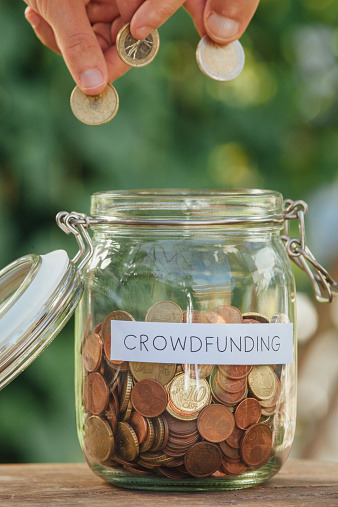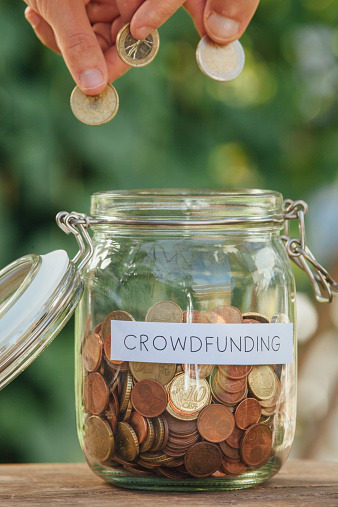
Cameron Postwait and Greg Petersen are serial entrepreneurs
who have used Kickstarter to successfully launch four products into the market
under their MOS Magnetic Organizational System
product line. They are fans of crowdfunding. But they freely admit that, while every
little bit of money helps, they don’t do it for the funding.
In fact, it’s the
“crowd” part of the exercise they find most valuable to the success of their
endeavors. Putting their ideas in front a crowd before designs are final – once
thought to be a huge mistake for anyone with a good idea – saves time and
money, improves their products, helps hone their marketing message, clarifies
their understanding of their market, and can prevent expensive mistakes. It
even gives them new ideas and has led them into business opportunities they would
never have come by otherwise. Like many other entrepreneurs who like
crowdfunding, their advice for anyone trying to launch a product: Crowdfund!
But don’t do it – necessarily – for the money.
“When you are trying to bring any idea to life, you face
three big challenges,” says Danae
Ringlemann, Co-Founder of Indiegogo. “The
first is the financing risk, were you can’t get enough money to get it done.
Then there is the market risk: That you are making something no one wants. And
the third is execution risk: You are solving a need but doing it wrong because
it is priced wrong or, in some other way, the market fit isn’t there.
Crowdfunding mitigates all of those risks.”
Money That’s Worth More than Money
Even when it comes to the funding part of crowdfunding, it’s
not just about the cold, hard cash the crowd kicks in. Even if you don’t get
enough money this way, and you might not, the money you do get is worth more
than its face value. The fact that someone paid money for a product you haven’t
created yet is, in itself, valuable. You can ask people if they will buy a
product you are planning to build. You can do market research. And you can
field surveys. (All of which can be very expensive.) But none of that will
really tell you what you need to know: Will people pay money for this exact
thing? A successful crowdfunding campaign tells you exactly that.
Because of this preview look at how an idea will fare in the
marketplace, even companies with no need for funding use the forum to test the
market for ideas. Recently Sony floated a crowdfunding campaign in Japan to
test a new
e-ink watch. Clearly, the company didn’t need the crowd to fund its watch.
But it did want the crowd to vote – with cold cash – on if it liked the concept
before going to the expense of creating, distributing, and marketing it.
Sam Shames, Co-Founder of embr labs,
puts it like this, “Until someone actually votes with their wallet, you really
don’t know if it’s going to be a successful idea. When people back an idea, it
shows that the dogs will eat the dog food.” His company was a finalist in
Intel’s Make It Wearable challenge
and is planning a crowdfunding campaign to launch its product – Wristify, a
bracelet that heats and cools.
“They are not just saying we would
buy it,” says
Indiegogo’s Ringlemann. “They are saying, ‘Here is
my money.’”
And that is worth more than the dollar amount the crowd pays you. You
can take that cash to the bank. But you can also you can take the proof of a
successful crowdfunding campaign to investors and get funding from
venture capitalists who previously wouldn’t return a phone call.
Everyone’s an Inventor
Better still? Those people who gave money to support your idea are now
much more than passive customers. They just became part of your development
team. They want you to succeed. And having a lot of people trying to help you
succeed can bring surprising benefits.
Marijn Berk and James Jeffrey used
Kickstarter to launch their Phorce
line of smart bags because the team wanted to get a feel for the people who
would buy their concept for a bag that charges devices and communicates with
smart phones. In the process they discovered that the people who would buy
their bag wouldn’t buy the one they were building. “We launched a product that
was inferior,” explains Berk. “We realized through the feedback from
our funders that people were excited about the idea but we had to do much more to
serve this market of professionals. We started refocusing and retargeting at
that specific demographic. And that meant we had to beef up the specs and the
materials, really everything about the product. We decided to make a great
product at a higher price point.”
Jason Aramburu, CEO and founder of Edyn, used Kickstarter to launch his
idea for a smart garden product that reads the soil, zone, and sunlight for a
spot in your garden and tells you via a smart-phone app what will grow there
and when it needs water. The Kickstarter community loved his idea. But they
told him two important things that made him change the product before he
finalized manufacturing: They wanted a battery that lasted longer than the 2.5
years he had initially designed into it. And they wanted an Android app. “We
thought 2.5 years would be sufficient for battery life,” he explains. “We also
thought that the market wanted to pay a lower a price, which informed our
battery decision. But we found the opposite was true.” So even though it raised
the price of the final product, he went back – in the middle of the campaign –
and redesigned the battery to double its life in the field. He also prioritized
the development of the Android app because the crowd was very clear on that
point.
Selling is Easy
And when it comes to advertising, marketing, and selling the
product, those people who bought in at the concept stage become worth their
weight in gold, no matter how much actual gold they kicked in. Imagine having
an army of people evangelizing, spreading the word on social media, and working
your product into party chatter. Who knows where that could lead?
“Mostly, we use crowdfunding to raise awareness for our
products,” explains MOS’s Postwait. That might sounds like a clever way to
boost sales – and it is – but it’s more than that. Awareness can bring
investors, partners, help, ideas, and an understanding of what customers plan
to use the product for when they finally get their hands on it. “On our first
Kickstarter,” says Postwait. “We planned to do a plastic version. But our
backers asked for an aluminum version. That aluminum version solidified us as a
design company and was what allowed us to get into Apple stores.”
For Edyn? “It created a lot of brand awareness and that got
the attention of retailers and investors.” You will find his smart gardening
product in Home Depot in 2015.
For the guys behind MOS? In addition to getting their MOS
product into Apple stores, the crowd led them into another business that has
turned out to be a surprising success. “We used a material – a sticky surface –
in our product that the maker community on Kickstarter asked us to sell to them
as a raw material,” explains Postwait. They had developed it as a part of
building their own end product but were happy to sell it to others for their
projects. Eventually, they had so many requests for that material that they
spun it out as its own company.
Fail Fast
Even a fail is a win. If you ask the crowd for funding and
get crickets in response, you have learned a valuable lesson. “Forty one
percent of campaigns don’t get their funding,” says Justin Kazmark, a
spokesperson for Kickstarter. “But there is no risk for a product that doesn’t succeed.
You aren’t putting money up front. If there is no response, that is good a very
good thing to know. You know early not to go forward. It takes courage to fail
publicly. But it doesn’t cost money.” In the world of entrepreneurs, that’s
called Failing Fast. And it’s much better than spending years of your life and
all of your money to find out that no one will buy your idea.
Christina
Tynan-Wood is a freelance writer living in California. She has written for many
national magazines and blogs at GeekGirlfriends.com.




